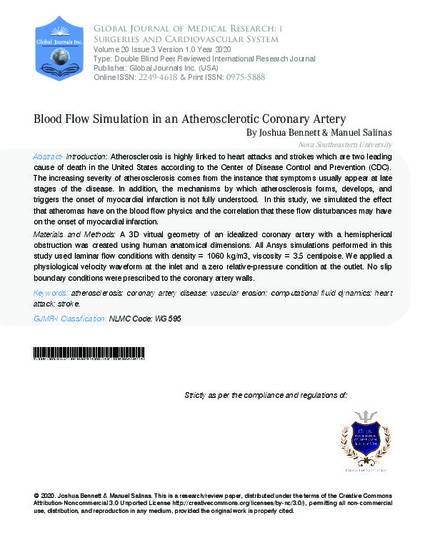
Article
Blood Flow Simulation in an Atherosclerotic Coronary Artery
Global Journal of Medical Research
(2020)
Abstract
Introduction
Atherosclerosis is highly linked to heart attacks and strokes which are two leading causes of death in the United States according to the Center of Disease Control and Prevention (CDC). The increasing severity of atherosclerosis comes from the instance that symptoms usually appear at late stages of the disease. In addition, the mechanisms by which atherosclerosis forms, develops, and triggers the onset of myocardial infarction is not fully understood. In this study, we simulated the effect that atheromas have on the blood flow physics and the correlation that these flow disturbances may have on the onset of myocardial infarction.
Materials and Methods
A 3D virtual geometry of an idealized coronary artery with a hemispherical obstruction was created using human anatomical dimensions. All Ansys simulations performed in this study used laminar flow conditions with density = 1060 kg/m3, viscosity = 3.5 centipoise. We applied a physiological velocity waveform at the inlet and a zero relative-pressure condition at the outlet. No slip boundary conditions were prescribed to the coronary artery walls.
Results and Discussion
We observed that the obstruction in the blood flow caused severe flow disturbance downstream from the atheroma. These time dependent cyclical flow profiles cause oscillatory velocities, pressures and shear stresses. These flow alterations have been linked to vessel erosion and may be a key factor on the onset of heart attacks.
Conclusions
In this study, we coupled an anatomically relevant time dependent velocity waveform with a segment of a coronary artery blocked by an atheroma. We have demonstrated that coronary arteries afflicted with atherosclerosis causes recirculation areas immediately downstream from the occlusion which are areas linked to vessel erosion and thrombus formation. The focus in our future work will be to incorporate vessel elasticity and movement. In addition, we hope to be able to correlate our results with tissue culture and small animal studies.
Keywords
- atherosclerosis,
- coronary artery disease,
- vascular erosion,
- heart attack,
- stroke,
- computational fluid dynamics
Disciplines
Publication Date
Fall September 28, 2020
Citation Information
Manuel Salinas and Joshua Bennett. "Blood Flow Simulation in an Atherosclerotic Coronary Artery" Global Journal of Medical Research Vol. 20 Iss. 3 (2020) p. ahead of print ISSN: 2249-4618 Available at: http://works.bepress.com/manuel-salinas/23/
